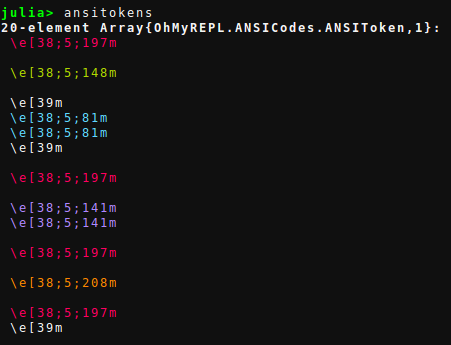Passes
In OhMyREPL each plugin that changes the way text is printed to the REPL is implemented as a pass. A pass is defined as a function (or a call overloaded type) that takes a list of Julia tokens from Tokenize.jl, a list of ANSITokens, the position of the cursor and sets the ANSITokens to however the pass wants the Julia tokens to be printed. Both the Syntax highlighting and the Bracket highlighting are implemented as passses.
All the passes are registered in a global pass handler. To show all the passes use OhMyREPL.showpasses():
julia> OhMyREPL.showpasses()
----------------------------------
# Pass name Enabled
----------------------------------
1 BracketHighlighter true
2 SyntaxHighlighter true
----------------------------------A pass can be enabled or disabled at will with OhMyREPL.enable_pass!(pass_name::String, enabled::Bool). As an example, we disable the syntax highlighting:

How a pass works
This section shows how text from the REPL get transformed into syntax highlighted text. The sample text used is:
str = "function f(x::Float64) return :x + 'a' end"First the text is tokenized with Tokenize.jl:
julia> using Tokenize
julia> tokens = collect(Tokenize.tokenize(str))
20-element Array{Tokenize.Tokens.Token,1}:
1,1-1,8: KEYWORD "function"
1,9-1,9: WHITESPACE " "
1,10-1,10: IDENTIFIER "f"
1,11-1,11: LPAREN "("
1,12-1,12: IDENTIFIER "x"
1,13-1,14: OP "::"
1,15-1,21: IDENTIFIER "Float64"
1,22-1,22: RPAREN ")"
1,23-1,23: WHITESPACE " "
1,24-1,29: KEYWORD "return"
1,30-1,30: WHITESPACE " "
1,31-1,31: OP ":"
1,32-1,32: IDENTIFIER "x"
1,33-1,33: WHITESPACE " "
1,34-1,34: OP "+"
1,35-1,35: WHITESPACE " "
1,36-1,38: CHAR "'a'"
1,39-1,39: WHITESPACE " "
1,40-1,42: KEYWORD "end"
1,43-1,42: ENDMARKER "" A vector of ANSITokens of the same length as the Julia tokens is then created and filled with empty tokens. .
ansitokens = Vector{OhMyREPL.ANSIToken}(length(tokens));
fill!(ansitokens, OhMyREPL.ANSIToken()) # ANSIToken is a bits type so this is OKThese two vectors are then sent to the syntax highlighter pass together with an integer that represent what character offset the cursor currently is located. The syntax highlighter does not use this information but the bracket highlighter does.
OhMyREPL.Passes.SyntaxHighlighter.SYNTAX_HIGHLIGHTER_SETTINGS(ansitokens, tokens, 0)Running this function has the effect of updating the ansitokens vector. If we print this vector we see that they have been updated:

To print the original string with the updated vector of ANSITokens we use the OhMyREPL.untoktenize_with_ANSI([io::IO], ansitokens, tokens) function as:

Each registered and enabled pass does this updating and the contributions from each pass to the ANSIToken vector is merged in to a separate vector. After each pass is done, the result is printed to the REPL.
Creating a pass
This section shows how to create a very pass that let the user define an ANSIToken for each type assertion / declaration that happens to be a Float64.
Please refer to the Tokenize.jl API and ANSIToken sections when reading this section.
We start off with a few imports and creating a new type which will hold the setting for the pass:
using Compat # For the call overloading syntax
import Tokenize.Tokens: Token, untokenize, exactkind
import OhMyREPL: ANSICodes.ANSIToken
type Float64Modifier
token::ANSIToken
end
# Default it the underlined red:
const FLOAT64_MODIFIER = Float64Modifier(ANSIToken(foreground = :red, underline= true))We then use call overloading to define a function for the type. The function will update the ANSIToken if the previous token was a :: operator and that the current token is a Float64 identifier, as in ::Float64.
# The pass function, the cursor position is not used but it needs to be given an argument
@compat function (float64modifier::Float64Modifier)(ansitokens::Vector{ANSIToken}, tokens::Vector{Token}, cursorpos::Int)
# Loop over all tokens and ansitokens
for i in 1:length(ansitokens)
if untokenize(tokens[i]) == "Float64"
if i > 1 && exactkind(tokens[i-1]) == Tokenize.Tokens.DECLARATION
# Update the ansi token
ansitokens[i] = float64modifier.token
end
end
end
endTesting the pass
A pass can be tested with the OhMyREPL.test_pass([io::IO], pass, str::String) where str is a test string to test the pass on:

Register the pass
To register and start using the pass simply use OhMyREPL.add_pass!(passname::String, pass):
julia> OhMyREPL.add_pass!("Redify Float64", FLOAT64_MODIFIER)
----------------------------------
# Pass name Enabled
----------------------------------
1 Redify Float64 true
2 BracketHighlighter true
3 SyntaxHighlighter true
----------------------------------We can now try it out together with the other passes by writing some syntax that includes ::Float64:

Modify prescedence of registered passes
We actually have a conflict now because both the syntax highlighter and the newly added pass will try to modify the properties of the printed Float64 token. This is where the prescedence of each pass come in. The order of each pass is executed from bottom up in the list given by OhMyREPL.show_passes(). As can be see above, the new pass has the highest prescedence which is why the color of Float64 is actually red.
The prescedence of a pass can be modified with the OhMyREPL.prescedence!(pass::Union{String, Int}, prescedence::Int). The variable pass here is either the name of the pass or its number as given by OhMyREPL.show_passes(). We now set the prescedence of the new pass to 3:
julia> OhMyREPL.prescedence!("Redify Float64", 3)
----------------------------------
# Pass name Enabled
----------------------------------
1 BracketHighlighter true
2 SyntaxHighlighter true
3 Redify Float64 true
----------------------------------Rewriting the same string in the REPL as above we now get:

The foreground color of Float64 is now determined by the Syntax highlighter pass. Note that the syntax highlighter does not touch the underlining so that one is still kept from the new pass.